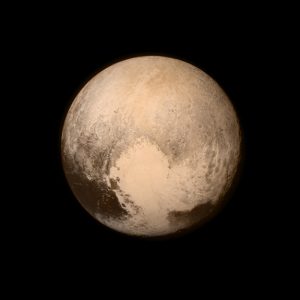The internet and news media are awash with news of “Planet Nine”. For the last few years astronomers have known that some of the objects orbiting the Sun beyond Pluto appear to be mysteriously aligned. One possible explanation for this is that there is a large body even further out and the gravity of that world is marshalling the objects inside it.
It is an exciting prospect, one that I wrote about in a magazine feature article several years ago. But while some media outlets are speaking as if Planet Nine has categorically been discovered, it hasn’t (for an excellent analysis of some of the problems with the idea, see here). But just as the prediction of a planet perturbing the orbit of Uranus led to the discovery of Neptune in the 19th century, this latest announcement is a call to arms for astronomers to scour the skies for a potential new world. We live in exciting times.

Pluto was reclassified as a dwarf planet in 2006 but not because of its size
However, one thing I’ve noticed in the media reporting of the story is that they often refer to Pluto’s reclassification as a dwarf planet and explain that the reason for the change is that Pluto was too small. In turn they say that the potential Planet Nine – thought to be 10 times more massive than the Earth – would definitely be big enough to be classified as a planet.
This is such a common mistake that I hear it almost every week. Size has little to do with planets. Here’s a quick reminder of the resolution passed by the International Astronomical Union in 2006 on planets:
A planet is a celestial body that:
(a) is in orbit around the Sun
(b) has sufficient mass for its self-gravity to overcome rigid body forces so that it assumes a hydrostatic equilibrium (nearly round) shape
(c) has cleared the neighbourhood around its orbit.
A “dwarf planet” is a celestial body that:
(a) is in orbit around the Sun
(b) has sufficient mass for its self-gravity to overcome rigid body forces so that it assumes a hydrostatic equilibrium (nearly round) shape
(c) has not cleared the neighbourhood around its orbit
(d)is not a satellite.
For condition (b) in both cases ignore all the scientific jargon and just read “round”. So to be a planet you must orbit the Sun, be round and be the boss of your orbit around the Sun.
It is because Pluto has not cleared the neighbourhood around its orbit that it was reclassified in 2006. Nothing to do with its size.

Collin:
Thanks for your article, but there is just so much more to this issue, that I fear we’ll not get it set right.
You are absolutely correct – there is NO requirement for a specific size, but then why call it “dwarf”. What a horrible name! Minor planet would be so much better.
You are absolutely correct – there IS a requirement to clear one’s orbit, but then…. Jupiter? Don’t look away… Yes, I’m going to ask again. No, I don’t care that you are the biggest. Size matters not. See point #1. So, tell me again about the Trojans and how that “doesn’t count”…?
Finally, You are absolutely correct – there IS a requirement to orbit the Sun, but then what about all those thousands of exo-PLANETS? No, they SPECIFICALLY said “the Sun”. Therefore, NONE of those exoplanets count as planets! Really?
You are absolutely correct – Pluto should be on the list that it is on (it is much more like Sedna and Eris than Jupiter and Venus), but the set of rules that put it there make absolutely no sense.
I agree the rules as they stand aren’t great – but they are the rules. The biggest issue with the whole definition is that it defines a planet as something that must orbit the Sun (not a Sun – THE Sun). So what are all the exoplanets?
I agree the rules need looking at again!